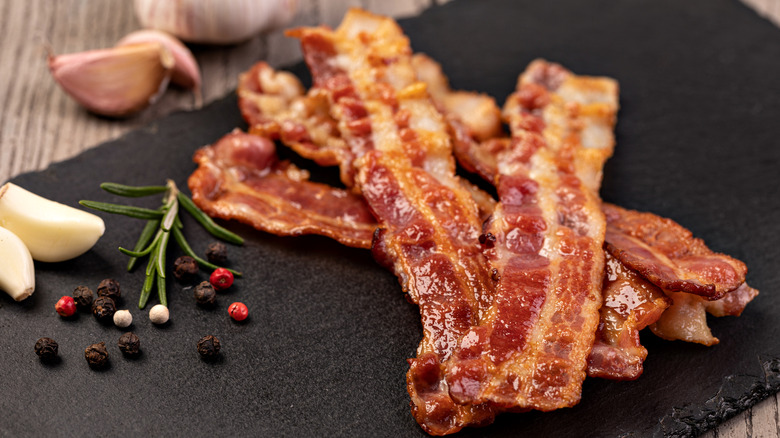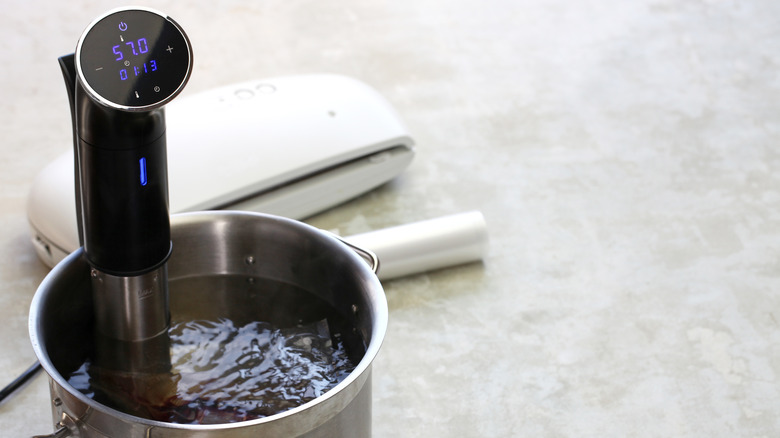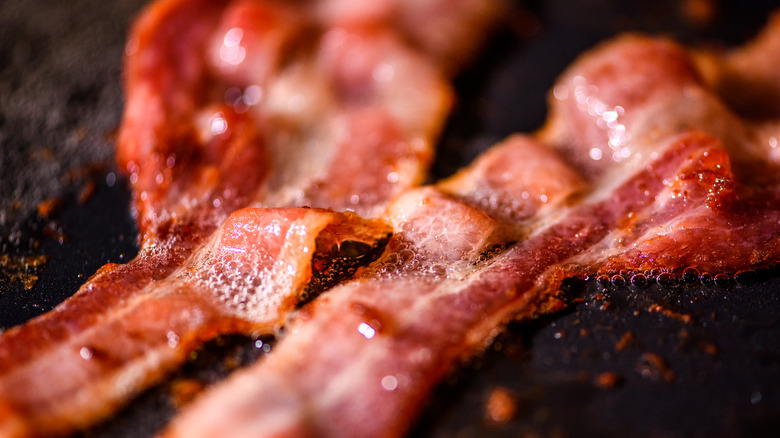For The Best Thick-Cut Bacon, Put Your Sous Vide To Work
There's a lot of debate over the best way to make bacon. Should it be cooked in a cast iron pan or in the oven? Should you add water? Can you microwave it? The answer depends on how much time you have, what kind of clean up you're willing to commit to, and how much bacon you're making. If you're only making a couple of pieces and you need them now, maybe the stovetop is better than the oven. But if you're making a whole batch and plan ahead, there's an option you may not have considered before: The sous vide.
It's time-consuming to sous vide bacon compared to frying it, but it's hands-off and wildly easy. Simply throw a sealed bag of bacon into a tub of water with the sous vide circulator set to 145 degrees Fahrenheit the night before and let it go until the morning. Drain the rendered fat, crisp the slices in a pan, and enjoy the best bacon ever.
The sexiest way to describe this method is that it is crispy, confit bacon. The bacon confits in its own rendered fat at low temperatures making it tender and succulent. Everyone has their individual bacon preferences; some like it soft, some like it crunchy, some like it indistinguishable from an artist's charcoal stick (if that's you, this method probably isn't recommended). After the bacon comes out of its sous vide bath, you can sear one or both sides depending on your bacon preferences.
Choosing bacon and preparing the sous vide
Sous vide is particularly great for thick-cut bacon like Thomas Keller's favorite brand because it will result in slices with a tender, chewy middle and crispy, crunchy exterior. Ideally, you'll find bacon with more pink (meat) than white (fat). If thinner bacon with a higher fat ratio is all you have on hand, don't fret. Le Cordon Bleu chef Steve Pennington experimented with this type of cut and found, to his surprise, it worked just fine.
Just like preparing any ingredients to go into a sous vide, the bacon should be put into a watertight, vacuum-sealed bag. This can be the bag the bacon is sold in, which is incredibly convenient. If there is a hole or defect in the seal of the bag or if you've opened it previously, your confit bacon will quickly take on water and become poached bacon. If there's any concern, put the bacon into a sturdy freezer bag.
The sous vide can be set at 145 degrees Fahrenheit, which is the FDA's recommended internal temperature for safely cooked pork. Fat begins to melt as low as 95-130 degrees Fahrenheit, so at 145 degrees Fahrenheit the bacon fat will melt without overcooking and drying out the meat. That's what makes this bacon less tough and stringy than traditional cooking methods. Then, by the time it's done, you can pour all that melted fat out through a cheesecloth ready to flavor other dishes.
Should you stop at sous vide bacon?
Something Steve Pennington recommends is chilling the bacon before searing it. When the bacon comes out of the sous vide, Pennington notes that it is hot and hard to separate. By chilling the bacon, it firms up and becomes easier to handle. Once the bacon is chilled, separate the slices and sear them in a hot pan. Those who prefer their bacon crispy will want to sear them on both sides. Those who like softer-cooked, chewier bacon can sear the slices on just one side to preserve the tenderness of the sous vide. How hot should the pan be? At 284-330 degrees Fahrenheit, the Maillard reaction begins and the bacon will develop a delicious brown sear — but from 325-375 degrees Fahrenheit, bacon fat can begin to burn.
If you don't have an infrared thermometer, you can try the water drop test; at the correct temperature, the water should instantly boil off. You should not see the Leidenfrost effect, where the water droplets bounce and dance but remain in the pan. Still, this is an imperfect test. Depending on your pan, the temperature could be around 400 degrees Fahrenheit before the Leidenfrost effect is achieved. Ultimately, if your bacon is smoking, your pan is too hot. Unless you're one of those people who like charcoal bacon.


